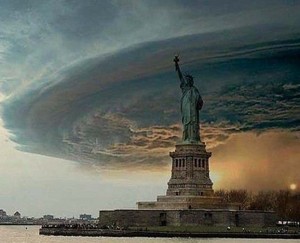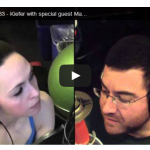What happens when you get derailed? When months of hard training and dedicated dieting are thrown off by events we think are beyond our control? We all love Carb Back-Loading and Carb Nite, and we all know how well they work, but what do you do when things go completely haywire?
First, you need to know that there are lots of ways to end up falling off track. Provided you’re healthy, this isn’t the end of the world. We all have to work long hours, we’re all in ongoing relationships with friends, significant others, and family—and in those relationships, shit can go sideways. Maybe you can’t get to the gym as often as you want to, or maybe you go through a week or two of so-called “comfort eating,” where something throws you for such a loop that you turn to food to make yourself feel better.
I was thrown for this sort of loop by Superstorm Sandy, and I’m still trying to get myself back to normal.
I’ll rewind for a minute and explain a few things about my situation. I’m a former fairly high-level athlete, but I’d let myself slip for a while in terms of my nutrition. I met Kiefer several years ago, and while he’s been incredibly helpful in teaching me a shitload about nutrition, I’m going to admit to doing something he hates: I’ve repeatedly used Carb Back-Loading as an excuse to eat like shit. This is something you have to be mindful of if you start either of his plans, because it’s very easy to think you’re doing the right thing by eating at Wendy’s every night. It’s even easier to start thinking of your two spicy chicken filets, your two large fries, and your large chocolate Frosty as a “healthy meal” that’s okay to eat anytime during the day as long as you’ve broken a sweat training.
 A few months ago, Kiefer straightened me out on multiple levels, and I committed to doing Carb Nite with a vengeance. In fact, I put in two ten-day prep periods in a row to start—doing the second one to reset my Carb Nite so it would fall on Sunday. After the first one, I lost twelve pounds and was in a great rhythm. Everything was working like a charm. I did the second one, lost even more weight, and was really rolling—doing everything the way I was supposed to, and staying on point for several more weeks.
A few months ago, Kiefer straightened me out on multiple levels, and I committed to doing Carb Nite with a vengeance. In fact, I put in two ten-day prep periods in a row to start—doing the second one to reset my Carb Nite so it would fall on Sunday. After the first one, I lost twelve pounds and was in a great rhythm. Everything was working like a charm. I did the second one, lost even more weight, and was really rolling—doing everything the way I was supposed to, and staying on point for several more weeks.
Then Sandy hit.
Now, I’ll spare you any kind of sob story here, because my experience with Sandy was rather tame. As of this writing, thousands of people in the New York/New Jersey area are still without homes, without cars, without power, and without warm clothing or enough to eat. Where I was, we had no power for the better part of two weeks, and supermarkets only carried dry goods. The stores that were open were running on generators, and there wasn’t any protein to be found anywhere—not that anyone gave a shit. All most people wanted was a place to charge their phone, some firewood, and an open gas station. We weren’t particularly worried about what we were eating as long as there was something there.
Again, this isn’t a complaint. I know plenty of guys who’ve gone away to Iraq and Afghanistan and come back in phenomenal shape because they found ways to get stuff done despite their circumstances. This was a learning experience more than anything else. I should have adapted, but I didn’t. I’m pissed off that I lost nearly two weeks of training, and I’ll do it differently the next time I’m involved in something like this.
Say what you will about “hardcore bodyweight training” and all the rest, but that stuff didn’t matter around here for a while. Most people were simply trying just to survive and subsist. I didn’t think much about training while we were all sleeping in the dark and cold and eating peanut butter sandwiches on stale bread with (questionable) tap water to wash it down. In retrospect, there were plenty of productive things I could have done with my time during this period, but again, I did what I thought mattered at the time. This involved cleaning up, gathering news to find out what was going on, finding open gas stations, and looking for a place to take a hot shower (I didn’t find one for a long while).

You can’t think about your hardcore training when Hurricane Sandy leaves you in a third-world state formerly know as New York.
That period, thankfully, came to an end. I eventually realized that I didn’t want to let months of consistent dieting and training go to waste. Although I was doing a lot of different things to help people out, I started seriously feeling like crap—and although I wasn’t eating a hell of a lot, it’s not the same as watching your macronutrient numbers, getting enough protein, and timing everything with your workouts to optimize your results. What I did is called “being a lazy piece of shit victim.”
So, after ten days of nothing, I was left with a body that hadn’t trained and hadn’t eaten enough of anything—other than beef jerky, which I suppose is okay. My fault. I didn’t prioritize correctly, and I used the storm as an excuse to fall off. When that time came to an end, however, I was annoyed and chomping at the bit to get back to training, so I decided to go to the gym.
My first session back was a squat day, and I felt like absolute shit. I practically gassed myself out going through my warm-up. I attribute this to the stresses I felt during the two weeks I took off. I wasn’t sleeping, I was worried about things—food, heat, power, water, gas, personal safety—that usually take care of themselves, and I think this all manifested itself in me being way more tired that I typically would be during my training.
With that said, here are five important lessons I’m taking from this experience.
- WHATEVER HAPPENS, DON’T STOP TRAINING. Your diet can go to hell, and everything around you can be chaos, but doing something—anything—can give you the mental edge you need to handle your business with a level head. I let this fall off, and I definitely paid for it with a decreased level of fitness and less mental strength when I got back in the gym.
- THERE’S ALWAYS SOMEONE WHO’S WORSE OFF THAN YOU ARE. This is something I’ve managed to remind myself of throughout everything, and it’s helped. My inconveniences were minor. I didn’t get hurt, I didn’t lose anyone, and insurance will cover anything that was damaged. I had no real excuse for missing so many training days and screwing up my diet as badly as I did. But I did, and it pisses me off.
- PLAN FOR CONTINGENCIES. My training and nutritional roll were just a house of cards. They came down hard with a little bit of pressure. Yes, sometimes you just need something to eat, and you’re not always going to be able to get your cage-free eggs, wild salmon, and grass-fed beef. So what? I dropped my plan far too quickly and didn’t put in any effort to stick with it because I gave myself an excuse to fail for a week and a half. This wasn’t necessary, and the key now is to figure out what I could have done about in lieu of throwing in the towel and waiting until conditions were back to perfect.
- BE A TOUGH GUY. I was tough in some ways—doing the work I need to do, not complaining about the situation, and finding supplies for people who needed them. I was kind of a p***y in other ways, though, and that has everything to do with using Sandy as a ready-made excuse to take time off. Things didn’t have to be that way, and all it would have taken was a little toughness, which I’m rather embarrassed not to have shown. As Mark Bell said to me about the training process, “This is a fight.” From now on, it damned sure will be.
- DON’T BE AFRAID TO START OVER. As a result of everything, I’m going back to the beginning of my diet and training cycle and starting over. It’s always hard, after an injury or a pause in training, to figure out where to pick things back up. In this case, I think I need to renew my commitment to what I’m doing, and resolve to not have this kind of lapse the next time something gets in the way.
Finally, I’d encourage everyone to find a trusted relief organization and donate something. Whether it’s money, food, supplies, or baby items, you’d need people doing this for you if disaster ever struck your area. In New York, we never thought this would happen to us. If it can happen here, it can happen anywhere—and when it does, you’ll need help. Take the time to find out how you can get involved.








Recent Comments